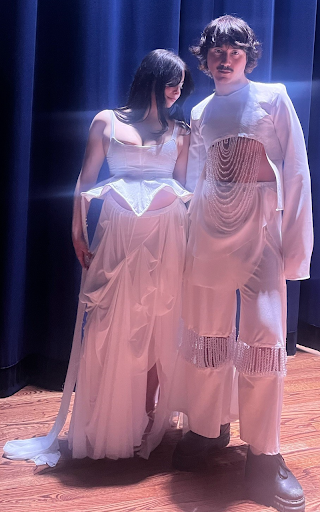
: Study of Biomes Fashion Show was put on by on March 9. Designers had the opportunity to create designs based on nature and the different biomes found around the world.
The Fabric Pantry is a student organization dedicated to providing students with cost-free fabrics and sewing materials. It is based out of Rockwell Hall room 306.
What is a ?
A biome is an area classified by the species that occupy it, temperature, water, and amount of light. Many more environmental factors can help define specific biomes.
Arctic Biome
Catherine MacGregor, a junior fashion design student, and Parker Riley, a sophomore fashion design student, said they immediately knew that they wanted the arctic as their biome. Two cohesive snowy white designs inspired by icicles and snowflakes formed in their minds.
The silhouettes were inspired by vintage fashion with The Snow King and Queen being large influences as well.
These influences can be seen with the wire icicle corset and cascading icicle pearl details located on the left. On the right, the fabric cutouts and detailed beading represent all forms of ice and snow and the beauty that comes with them.
As sustainability is one of the main themes of the Ecosphere Fashion Show, Catherine and Parker were very cautious when sourcing materials. This led them to choose nontypical materials such as bed sheets and shower curtains. Most materials were obtained from thrift stores or found around their homes.
Jungle Biome
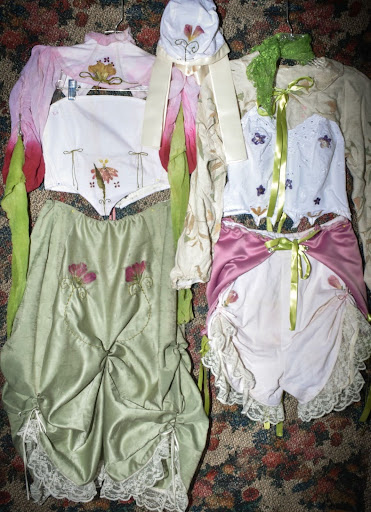
Nina Gwin settled for the jungle biome because of its vast opportunities, much like the real thing. Infatuated with flora and ecological diversity, her ideas quickly sprouted.
“I had a lot of fun experimenting with real plants to use in the designs. I pressed a generous amount of flower petals and tried a few different preservatives for them. I made small collages on the fabric with the petals and embroidery, which I’ve also never really done before,” Gwin said.
Gwin used materials from the Fabric Pantry to create the mid-length green skirt on the left. She said whenever she is about to start a large project, she always stops there first. She typically sources all other materials from vintage fabric stores or thrift stores.
Nina said she pulls a lot of inspiration from nature and its diversity. These Ecosphere designs were also partly inspired by a short film called .
“The animation depicts nature with so much attention to detail, and I wanted to emulate the curiosity and appreciation for detail in my garments,” she said.
Ocean Biome
Julien Proffitt, a junior fashion design major, named the micro collection they made for the Ecosphere Fashion Show “The Sailor and The Siren.”
Julien was inspired by vintage sailor aesthetics and the wide ocean. They really enjoyed playing with crashing waves and bridalwear. A storybook element is maintained while providing queer representation in the bridalwear space.
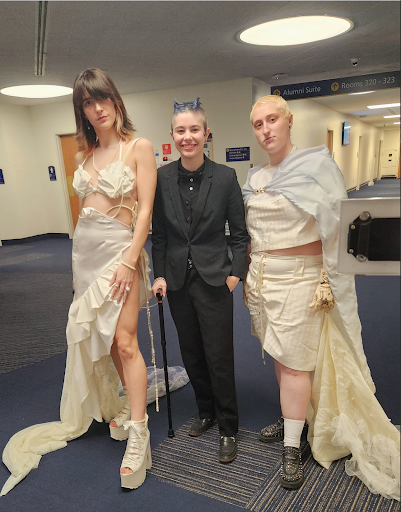
“The Siren,” located on the left, is inspired by the fairytale creature and waves they reside in. On the right, “The Sailor” is influenced by a masculine bridal silhouette with a classical sailor twist.
“There aren’t a lot of outlets on campus for students to showcase their designs in a fashion show without a monetary or academic barrier to entry, so The Fabric Pantry hosting these shows fills an extremely important niche. The Ecosphere Fashion Show in particular lent so much awareness not only to local designers but environmental activism and sustainability,” Proffitt said.
Desert Biome
Drea Favorito chose her biome for a different reason than most. She had the least amount of experience with the desert out of most other biomes. This led to much research and thinking out of the box. Favorito knew that fabric and textures would be essential to bring these to life.
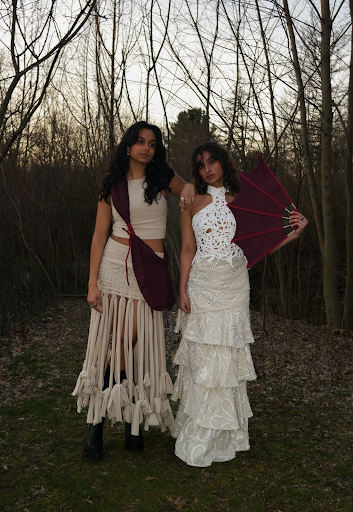
“I created my own textile with polyester rope from Lowe’s, which I ended up loving and the organic swirling shapes were a loose interpretation of sand dunes. I also hand wove the skirt with polar fleece to add texture to the outfit,” she said.
Favorito tries to represent when using materials saying she has donated to The Fabric Pantry numerous times and have also taken offered materials. Favorito went on to say that The Fabric Pantry created a really special moment as this was the first time she got to see her creations walking down the runway.
Jungle Biome
Hayden Davis is a sophomore fashion design student who operates under the brand tag “vagabond vetements.”
The main theme of these designs is growth and decay and the relationship between the two. Davis chose to incorporate these themes using jungle patterns in his work.
The first design features a burlap poncho with chia seeds growing through the fabric. This unique ecosystem truly captures the main themes, growth and decay.
The second design on the right features jungle paisley print collared jacket paired with butterfly denim hakama shorts, as well as an assortment of 3D-printed butterfly accessories.
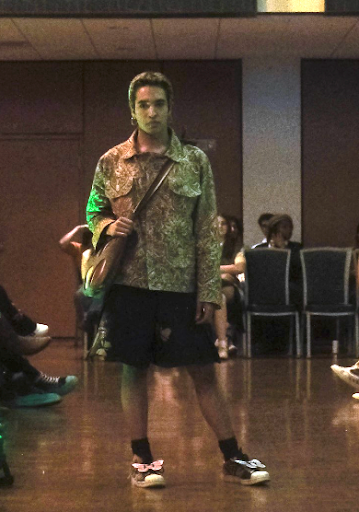
Daviss’ materials mostly come from secondhand stores.
“I utilize the Pantry very frequently; I believe it’s a great resource for students to utilize because it teaches them how to create with what they have instead of what they want and can often broaden the perspective of the designer,” he said.
Zach Rayz is a reporter. Contact him at zrayz@kent.edu.
